GE JS750SF4SS, JS750SF3SS, JS750SF2SS, JS750SF1SS, JS750EF4ES Owner’s Manual
...
RANGES
Electric Free-Standing, Slide-In, and Drop-In
SAFETY INFORMATION . . . . . . . . . . 3
USING THE RANGE
Surface Units. . . . . . . . . . . . . . . . . . . . . . . . . . . 8 Cookware for Radiant Glass Cooktop. . . . . . 11 Oven Controls. . . . . . . . . . . . . . . . . . . . . . . . . .12 Special Features . . . . . . . . . . . . . . . . . . . . . . . .14 Oven Racks . . . . . . . . . . . . . . . . . . . . . . . . . . . .15 Aluminum Foil and Oven Liners. . . . . . . . . . .16 Cookware. . . . . . . . . . . . . . . . . . . . . . . . . . . . . .16 Cooking Modes . . . . . . . . . . . . . . . . . . . . . . . . .16 Cooking Guide . . . . . . . . . . . . . . . . . . . . . . . . .18 Warming Drawer . . . . . . . . . . . . . . . . . . . . . . .19
CARE AND CLEANING
Cleaning the Range – Exterior . . . . . . . . . . . 20
Cleaning the Range – Interior . . . . . . . . . . . .21
Cleaning the Glass Cooktop . . . . . . . . . . . . . 22
Oven Light. . . . . . . . . . . . . . . . . . . . . . . . . . . . 23
Oven Door . . . . . . . . . . . . . . . . . . . . . . . . . . . . 24
Storage Drawer. . . . . . . . . . . . . . . . . . . . . . . . 24
Removable Warming Drawer Pan . . . . . . . . 25
Probe . . . . . . . . . . . . . . . . . . . . . . . . . . . . . . . . 25
TROUBLESHOOTING TIPS. . . . . . . 26
WARRANTY. . . . . . . . . . . . . . . . . . . . . . . 30
ACCESSORIES . . . . . . . . . . . . . . . . . . . . .31
CONSUMER SUPPORT . . . . . . . . . . . 32
Write the model and serial numbers here:
Model #_________________
Serial # _________________
You can find them on a label behind the door or drawer.
OWNER’S MANUAL
JB740 - 30" Free-Standing Range
JB745 - 30" Free-Standing Range
JB750 - 30" Free-Standing Range
PB930 - 30" Free-Standing Range
JD750 - 30" Drop-In Range
JS750 - 30" Slide-In Range
ESPAÑOL
Para consultar una version en español de este manual de instrucciones, visite nuestro sitio de internet GEAppliances.com.
GE is a trademark of the General Electric Company. Manufactured under trademark license.
49-80690-5 03-17 GEA

THANK YOU FOR MAKING GE APPLIANCES A PART OF YOUR HOME.
Whether you grew up with GE Appliances, or this is your first, we’re happy to have you in the family.
We take pride in the craftsmanship, innovation and design that goes into every GE Appliances product, and we think you will too. Among other things, registration of your appliance ensures that we can deliver important product information and warranty details when you need them.
Register your GE appliance now online. Helpful websites and phone numbers are available in the Consumer Support section of this Owner’s Manual. You may also mail in the pre-printed registration card included in the packing material.
2 |
|
49-80690-5 |
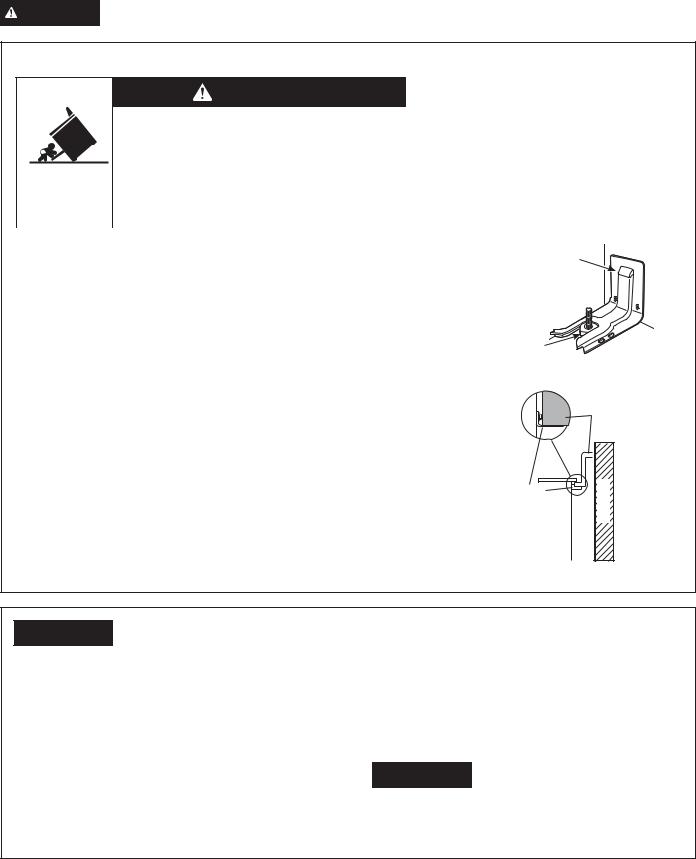
IMPORTANT SAFETY INFORMATION
READ ALL INSTRUCTIONS BEFORE USING THE APPLIANCE
WARNING Read all safety instructions before using the product. Failure to follow these instructions may result in fire, electrical shock, serious injury or death.
ANTI-TIP DEVICE
To reduce the risk of tipping the range, the range must be secured by a properly installed anti-tip bracket. See installation instructions shipped with the bracket for
complete details before attempting to install.
For Free-Standing and Slide-In Ranges
To check if the bracket is installed and engaged properly, look underneath the range to see that the rear leveling leg is
engaged in the bracket. On some models, the storage drawer or kick panel can be removed for easy inspection. If visual inspection is not possible, slide the range forward, confirm the anti-tip bracket is securely attached to the floor or wall, and slide the range back so the rear leveling leg is under the anti-tip bracket.
If the range is pulled from the wall for any reason, always repeat this procedure to verify the range is properly secured by the anti-tip bracket.
Never completely remove the leveling legs or the range will not be secured to the anti-tip device properly.
For Drop-In Ranges
To check if the bracket is installed and engaged properly, slide the range forward, confirm the anti-tip bracket is securely attached to the rear of the range, and slide the range back so that the anti-tip bracket slides just under the countertop or wood block attached to the rear wall.
If you did not receive an anti-tip bracket with your purchase, call 1.800.626.8774 to receive one at no cost (in Canada, call 1.800.561.3344). For installation instructions of the bracket, visit GEAppliances.com
(in Canada, GEAppliances.ca).
Anti-Tip |
Wall |
Bracket |
|
Oven |
Rear |
|
'URS ,Q 5DQJHV

 WARNING GENERAL SAFETY INSTRUCTIONS
WARNING GENERAL SAFETY INSTRUCTIONS
Ŷ 8VH WKLV DSSOLDQFH RQO\ IRU LWV LQWHQGHG SXUSRVH DV described in this Owner’s Manual.
Ŷ %H VXUH \RXU DSSOLDQFH LV SURSHUO\ LQVWDOOHG DQG grounded by a qualified installer in accordance with the provided installation instructions.
Ŷ 'R QRW DWWHPSW WR UHSDLU RU UHSODFH DQ\ SDUW RI \RXU range unless it is specifically recommended in this manual. All other servicing should be transferred to a qualified technician.
Ŷ %HIRUH SHUIRUPLQJ DQ\ VHUYLFH XQSOXJ WKH UDQJH or disconnect the power supply at the household
distribution panel by removing the fuse or switching off the circuit breaker.
Ŷ 'R QRW OHDYH FKLOGUHQ DORQH FKLOGUHQ VKRXOG QRW be left alone or unattended in an area where an appliance is in use. They should never be allowed to climb, sit or stand on any part of the appliance.
Ŷ 
 CAUTION 'R QRW VWRUH LWHPV RI LQWHUHVW WR children above a range or on the backguard of a
CAUTION 'R QRW VWRUH LWHPV RI LQWHUHVW WR children above a range or on the backguard of a
UDQJH FKLOGUHQ FOLPELQJ RQ WKH UDQJH WR UHDFK items could be seriously injured.
READ AND SAVE THESE INSTRUCTIONS
INFORMATION SAFETY
49-80690-5 |
3 |
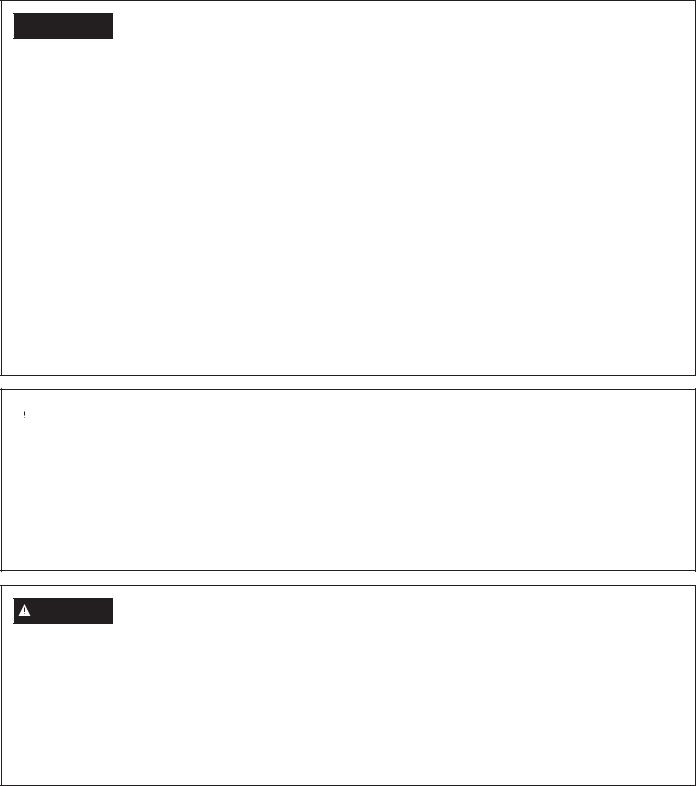
SAFETY INFORMATION
IMPORTANT SAFETY INFORMATION
READ ALL INSTRUCTIONS BEFORE USING THE APPLIANCE

 WARNING GENERAL SAFETY INSTRUCTIONS (Cont.)
WARNING GENERAL SAFETY INSTRUCTIONS (Cont.)
Ŷ 8VH RQO\ GU\ SRW KROGHUV PRLVW RU GDPS SRW holders on hot surfaces may result in burns from
VWHDP 'R QRW OHW SRW KROGHUV WRXFK KRW VXUIDFH
XQLWV RU KHDWLQJ HOHPHQWV 'R QRW XVH D WRZHO RU other bulky cloth in place of pot holders.
Ŷ 1HYHU XVH \RXU DSSOLDQFH IRU ZDUPLQJ RU KHDWLQJ the room.
Ŷ 'R QRW WRXFK WKH VXUIDFH XQLWV WKH KHDWLQJ HOHPHQWV or the interior surface of the oven. These surfaces may be hot enough to burn even though they are
GDUN LQ FRORU 'XULQJ DQG DIWHU XVH GR QRW WRXFK or let clothing or other flammable materials contact the surface units, areas nearby the surface units or any interior area of the oven; allow sufficient time for cooling first. Other surfaces of the appliance may become hot enough to cause burns. Potentially hot surfaces include the cooktop, areas facing the cooktop, oven vent opening, surfaces near the opening and crevices around the oven door.
Ŷ 'R QRW KHDW XQRSHQHG IRRG FRQWDLQHUV 3UHVVXUH could build up and the container could burst, causing an injury.
Ŷ 'R QRW XVH DQ\ W\SH RI IRLO RU OLQHU WR FRYHU WKH oven bottom or anywhere in the oven, except as described in this manual. Oven liners can trap heat or melt, resulting in damage to the product and risk of shock, smoke or fire.
Ŷ $YRLG VFUDWFKLQJ RU LPSDFWLQJ JODVV GRRUV FRRN WRSV RU FRQWURO SDQHOV 'RLQJ VR PD\ OHDG WR JODVV
EUHDNDJH 'R QRW FRRN RQ D SURGXFW ZLWK EURNHQ glass. Shock, fire or cuts may occur.
Ŷ &RRN PHDW DQG SRXOWU\ WKRURXJKO\ PHDW WR DW OHDVW an internal temperature of 160°F and poultry to at least an internal temperature of 180°F. Cooking
to these temperatures usually protects against foodborne illness.
|
KEEP FLAMMABLE MATERIALS AWAY FROM THE RANGE |
WARNING |
|
|
Failure to do so may result in fire or personal injury. |
|
Ŷ 'R QRW VWRUH RU XVH IODPPDEOH PDWHULDOV LQ DQ RYHQ |
Ŷ 'R QRW OHW FRRNLQJ JUHDVH RU RWKHU IODPPDEOH |
or near the cooktop, including paper, plastic, pot |
materials accumulate in or near the range. Grease |
holders, linens, wall coverings, curtains, drapes and |
in the oven or on the cooktop may ignite. |
gasoline or other flammable vapors and liquids. |
Ŷ &OHDQ YHQWLODWLQJ KRRGV IUHTXHQWO\ *UHDVH VKRXOG |
|
|
Ŷ 1HYHU ZHDU ORRVH ILWWLQJ RU KDQJLQJ JDUPHQWV ZKLOH |
not be allowed to accumulate on the hood or filter. |
using the appliance. These garments may ignite if |
|
they contact hot surfaces causing severe burns. |
|
WARNING IN THE EVENT OF A FIRE, TAKE THE FOLLOWING STEPS TO PREVENT INJURY AND FIRE SPREADING
Ŷ 'R QRW XVH ZDWHU RQ JUHDVH ILUHV 1HYHU SLFN XS a flaming pan. Turn the controls off. Smother a flaming pan on a surface unit by covering the pan completely with a well-fitting lid, cookie sheet or flat
WUD\ 8VH D PXOWL SXUSRVH GU\ FKHPLFDO RU IRDP W\SH fire extinguisher.
Ŷ ,I WKHUH LV D ILUH LQ WKH RYHQ GXULQJ EDNLQJ VPRWKHU the fire by closing the oven door and turning the
oven off or by using a multi-purpose dry chemical or foam-type fire extinguisher.
Ŷ ,I WKHUH LV D ILUH LQ WKH RYHQ GXULQJ VHOI FOHDQ WXUQ the oven off and wait for the fire to go out. 'R QRW force the door open. Introduction of fresh air at selfclean temperatures may lead to a burst of flame from the oven. Failure to follow this instruction may result in severe burns.
READ AND SAVE THESE INSTRUCTIONS
4 |
49-80690-5 |
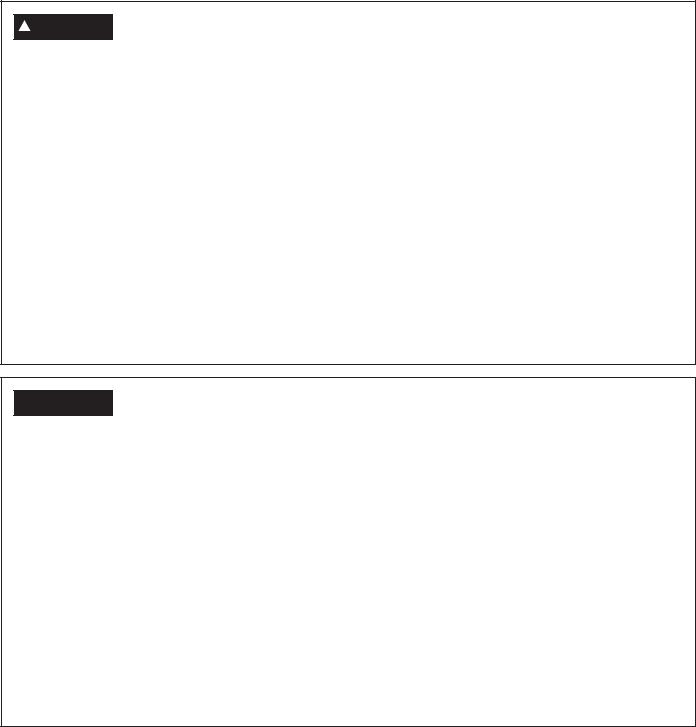
IMPORTANT SAFETY INFORMATION
READ ALL INSTRUCTIONS BEFORE USING THE APPLIANCE

 WARNING COOKTOP SAFETY INSTRUCTIONS
WARNING COOKTOP SAFETY INSTRUCTIONS
Ŷ 1HYHU OHDYH WKH VXUIDFH XQLWV XQDWWHQGHG DW PHGLXP or high heat settings. Boilovers cause smoking and greasy spillovers that may catch on fire.
Ŷ 1HYHU OHDYH RLO XQDWWHQGHG ZKLOH IU\LQJ ,I DOORZHG to heat beyond its smoking point, oil may ignite resulting in fire that may spread to surrounding
FDELQHWV 8VH D GHHS IDW WKHUPRPHWHU ZKHQHYHU possible to monitor oil temperature.
Ŷ 7R DYRLG RLO VSLOORYHU DQG ILUH XVH D PLQLPXP amount of oil when shallow pan-frying and avoid cooking frozen foods with excessive amounts of ice.
Ŷ 8VH SURSHU SDQ VL]H VHOHFW FRRNZDUH KDYLQJ flat bottoms large enough to cover the surface heating element. The use of undersized cookware will expose a portion of the surface unit to direct
contact and may result in ignition of clothing. Proper relationship of cookware to surface unit will also improve efficiency.
Ŷ 2QO\ FHUWDLQ W\SHV RI JODVV JODVV FHUDPLF earthenware or other glazed containers are suitable for cooktop service; others may break because of the sudden change in temperature.
Ŷ 7R PLQLPL]H WKH SRVVLELOLW\ RI EXUQV LJQLWLRQ RI flammable materials and spillage, the handle of a container should be turned toward the center of the range without extending over nearby surface units.
Ŷ :KHQ SUHSDULQJ IODPLQJ IRRGV XQGHU D KRRG WXUQ the fan on.
Ŷ ,I SRZHU LV ORVW WR DQ HOHFWULF FRRNWRS ZKLOH D VXUIDFH unit is ON, the surface unit will turn back on as
soon as power is restored. In the event of power loss, failure to turn all surface unit knobs to the OFF position may result in ignition of items on or near the cooktop, leading to serious injury or death.

 WARNING RADIANT COOKTOP SAFETY INSTRUCTIONS
WARNING RADIANT COOKTOP SAFETY INSTRUCTIONS
Ŷ 8VH FDUH ZKHQ WRXFKLQJ WKH FRRNWRS 7KH JODVV surface of the cooktop will retain heat after the controls have been turned off.
Ŷ 'R QRW FRRN RQ D EURNHQ FRRNWRS ,I JODVV FRRNWRS should break, cleaning solutions and spillovers may penetrate the broken cooktop and create a risk of electric shock. Contact a qualified technician immediately.
Ŷ $YRLG VFUDWFKLQJ WKH JODVV FRRNWRS 7KH FRRNWRS can be scratched with items such as knives, sharp instruments, rings or other jewelry, and rivets on clothing.
Ŷ 'R QRW SODFH RU VWRUH LWHPV WKDW FDQ PHOW RU FDWFK fire on the glass cooktop, even when it is not being used. If the cooktop is inadvertently turned on, they may ignite. Heat from the cooktop or oven vent after it is turned off may cause them to ignite also.
Ŷ 8VH &(5$0$ %5<7(® ceramic Cooktop Cleaner and CERAMA BRYTE® Cleaning Pad to clean the cooktop. Wait until the cooktop cools and the indicator light goes out before cleaning. A wet sponge or cloth on a hot surface can cause steam
burns. Some cleaners can produce noxious fumes if applied to a hot surface. NOTE: Sugar spills are an exception. They should be scraped off while still hot using an oven mitt and a scraper. See the Cleaning the glass cooktop section for detailed instructions.
Ŷ 5HDG DQG IROORZ DOO LQVWUXFWLRQV DQG ZDUQLQJV RQ WKH cleaning cream label.
INFORMATION SAFETY
READ AND SAVE THESE INSTRUCTIONS
49-80690-5 |
5 |
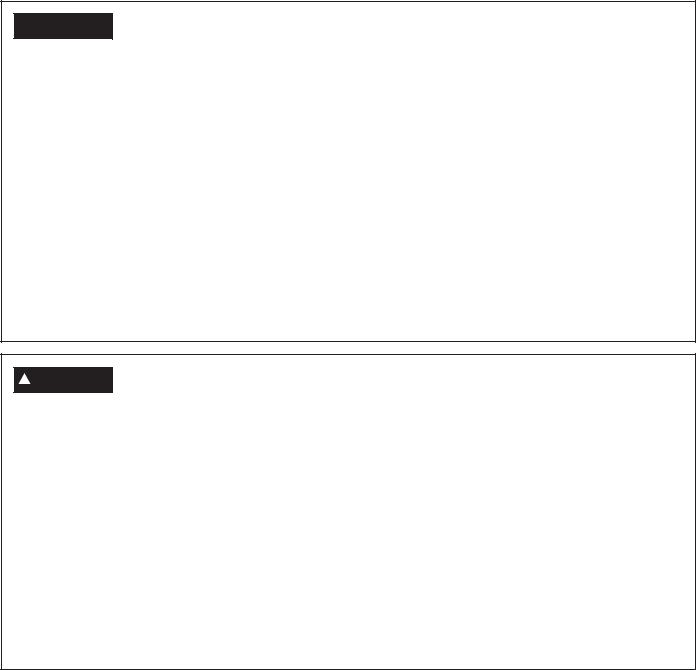
SAFETY INFORMATION
IMPORTANT SAFETY INFORMATION
READ ALL INSTRUCTIONS BEFORE USING THE APPLIANCE

 WARNING OVEN SAFETY INSTRUCTIONS
WARNING OVEN SAFETY INSTRUCTIONS
Ŷ 6WDQG DZD\ IURP WKH UDQJH ZKHQ RSHQLQJ WKH RYHQ |
Ŷ :KHQ XVLQJ FRRNLQJ RU URDVWLQJ EDJV LQ WKH RYHQ |
door. Hot air or steam which escapes can cause |
follow the manufacturer’s directions. |
EXUQV WR KDQGV IDFH DQG RU H\HV
Ŷ 'R QRW XVH WKH RYHQ LI D KHDWLQJ HOHPHQW GHYHORSV a glowing spot during use or shows other signs
of damage. A glowing spot indicates the heating element may fail and present a potential burn, fire, or shock hazard. Turn the oven off immediately and have the heating element replaced by a qualified service technician.
Ŷ .HHS WKH RYHQ YHQW XQREVWUXFWHG
Ŷ .HHS WKH RYHQ IUHH IURP JUHDVH EXLOGXS *UHDVH LQ the oven may ignite.
Ŷ 3ODFH RYHQ UDFNV LQ GHVLUHG ORFDWLRQ ZKLOH RYHQ LV cool. If rack must be moved while oven is hot, do not let pot holder contact hot heating element in oven.
Ŷ 3XOO WKH RYHQ UDFN WR WKH VWRS ORFN SRVLWLRQ ZKHQ loading and unloading food from the oven. This helps prevent burns from touching hot surfaces of the door and oven walls.
Ŷ 'R QRW OHDYH LWHPV VXFK DV SDSHU FRRNLQJ XWHQVLOV or food in the oven when not in use. Items stored in an oven can ignite.
Ŷ 1HYHU SODFH FRRNLQJ XWHQVLOV SL]]D RU EDNLQJ VWRQHV or any type of foil or liner on the oven floor. These items can trap heat or melt, resulting in damage to the product and risk of shock, smoke or fire.

 WARNING SELF-CLEANING OVEN SAFETY INSTRUCTIONS
WARNING SELF-CLEANING OVEN SAFETY INSTRUCTIONS
The self-cleaning feature operates the oven at temperatures high enough to burn away food soils in the oven. Follow these instructions for safe operation.
Ŷ 'R QRW WRXFK RYHQ VXUIDFHV GXULQJ VHOI FOHDQ operation. Keep children away from the oven during self-cleaning. Failure to follow these instructions may cause burns.
Ŷ %HIRUH RSHUDWLQJ WKH VHOI FOHDQ F\FOH UHPRYH SDQV shiny metal oven racks and other utensils from the oven. Only gray porcelain-coated oven racks may
EH OHIW LQ WKH RYHQ 'R QRW XVH VHOI FOHDQ WR FOHDQ other parts, such as drip pans or bowls.
Ŷ %HIRUH RSHUDWLQJ WKH VHOI FOHDQ F\FOH ZLSH JUHDVH and food soils from the oven. Excessive amount of grease may ignite leading to smoke damage to your home.
Ŷ ,I WKH VHOI FOHDQLQJ PRGH PDOIXQFWLRQV WXUQ WKH oven off and disconnect the power supply. Have it serviced by a qualified technician.
Ŷ 'R QRW FOHDQ WKH GRRU JDVNHW 7KH GRRU JDVNHW LV essential for a good seal. Care should be taken not to rub, damage or move the gasket.
Ŷ 'R QRW XVH RYHQ FOHDQHUV 1R FRPPHUFLDO RYHQ cleaner or oven liner protective coating of any kind should be used in or around any part of the oven.
READ AND SAVE THESE INSTRUCTIONS
6 |
49-80690-5 |
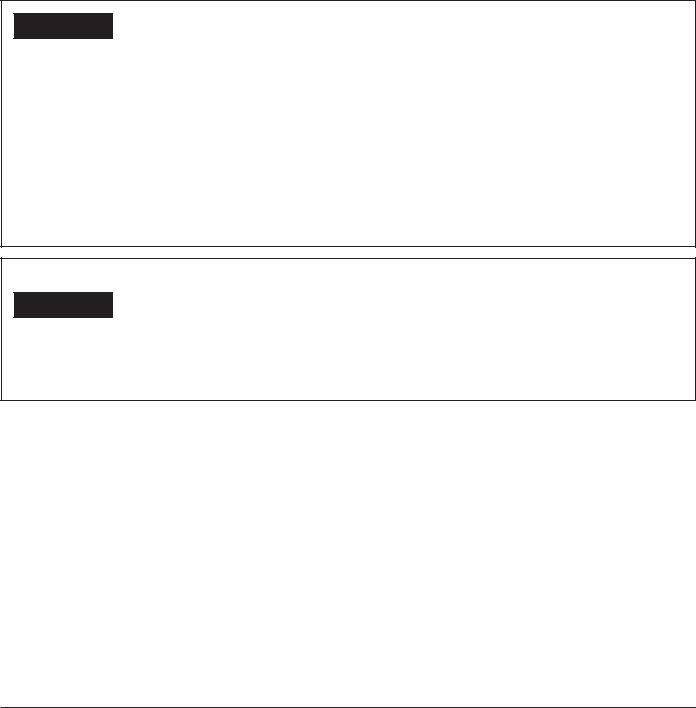
IMPORTANT SAFETY INFORMATION
READ ALL INSTRUCTIONS BEFORE USING THE APPLIANCE

 WARNING WARMING DRAWER SAFETY INSTRUCTIONS (some models)
WARNING WARMING DRAWER SAFETY INSTRUCTIONS (some models)
Ŷ 7KH SXUSRVH RI WKH ZDUPLQJ GUDZHU LV WR KROG KRW cooked foods at serving temperature. Bacteria will
JURZ LQ IRRG ZKLOH LW LV EHORZ ) 'R QRW SXW FROG
IRRG LQ ZDUPLQJ GUDZHU 'R QRW KHDW IRRG IRU PRUH than 2 hours. Failure to follow these instructions may result in foodborne illness.
Ŷ 'R QRW OHDYH SDSHU SURGXFWV SODVWLFV FDQQHG IRRG RU combustible materials in the drawer. They may ignite.
Ŷ 'R QRW WRXFK WKH KHDWLQJ HOHPHQW RU WKH LQWHULRU surface of the drawer. These surfaces may be hot enough to cause burns.
Ŷ 8VH FDUH ZKHQ RSHQLQJ WKH GUDZHU 2SHQ WKH GUDZHU a crack and let hot air or steam escape before removing or replacing food. Hot air or steam that
HVFDSHV FDQ FDXVH EXUQV WR KDQGV IDFH DQG RU H\HV
Ŷ 'R QRW XVH DOXPLQXP IRLO WR OLQH WKH ORZHU drawer. The foil will trap heat below, and upset the performance of the oven. Foil can melt and
SHUPDQHQWO\ GDPDJH WKH GUDZHU ERWWRP 'DPDJH from improper use of aluminum foil is not covered by the product warranty.
STATE OF CALIFORNIA PROPOSITION 65 WARNINGS

 WARNING This product contains one or more chemicals known to the State of California to cause cancer, and birth defects or other reproductive harm.
WARNING This product contains one or more chemicals known to the State of California to cause cancer, and birth defects or other reproductive harm.
Self clean ovens can cause low level exposure to some of the Proposition 65 substances, including carbon monoxide, during the cleaning cycle. Exposure to these substances can be minimized by opening a window or using a ventilation fan or hood.
The remote enable equipment installed on some models has been tested and found to comply with the limits for a Class B digital device, pursuant
to part 15 of the FCC Rules. These limits are designed to:
(a) provide reasonable protection against harmful interference in a residential installation. This equipment generates, uses and can radiate radio frequency energy and, if not installed and used in accordance with the instructions, may cause harmful interference to radio communications. However, there is no guarantee that interference will not occur in a particular installation. If this
equipment does cause harmful interference to radio or television reception, which can be determined by turning the equipment off and on, the user is encouraged to try to correct the interference by one or more of the following measures:
Ŷ 5HRULHQW RU UHORFDWH WKH UHFHLYLQJ DQWHQQD
Ŷ ,QFUHDVH WKH VHSDUDWLRQ EHWZHHQ WKH HTXLSPHQW and receiver.
Ŷ &RQQHFW WKH HTXLSPHQW LQWR DQ RXWOHW RQ D circuit different from that to which the receiver is connected.
Ŷ &RQVXOW WKH GHDOHU RU DQ H[SHULHQFHG UDGLR 79 technician for help.
(b) accept any interference received, including interference that may cause undesired operation of the device.
Note that any changes or modifications to the wireless communication device installed on this oven that are not expressly approved by the manufacturer could void the user's authority to operate the equipment.
How to Remove Protective Shipping Film and Packaging Tape
Carefully grasp a corner of the protective shipping film with your fingers and slowly peel it from the appliance
VXUIDFH 'R QRW XVH DQ\ VKDUS LWHPV WR UHPRYH WKH ILOP
Remove all of the film before using the appliance for the first time.
To assure no damage is done to the finish of the product, the safest way to remove the adhesive from packaging tape on new appliances is an application of a household liquid dishwashing detergent. Apply with a soft cloth and allow to soak.
NOTE: The adhesive must be removed from all parts. It cannot be removed if it is baked on.
READ AND SAVE THESE INSTRUCTIONS
INFORMATION SAFETY
49-80690-5 |
7 |
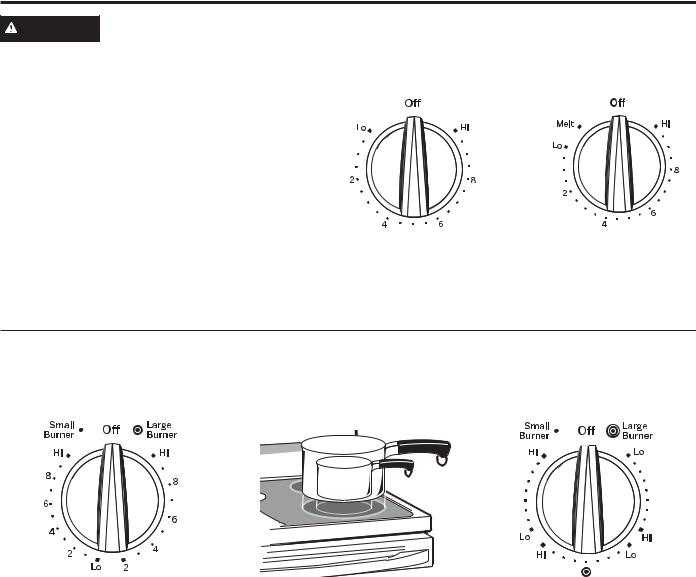
USING THE RANGE:6XUIDFH8QLWV
Surface Units
WARNING FIRE HAZARD: Never leave the range unattended with the cooktop on medium or high settings. Keep flammable items away from the cooktop. Turn off all controls when done cooking. Failure to
follow these instructions can result in fire, serious injury or death. Throughout this manual, features and appearance may vary from your model.
How to Set
Push the knob in and turn in either direction to the setting you want.
A surface ON indicator light will glow when any surface unit is on
For glass cooktop surfaces:
A HOT COOKTOP indicator light will:
Ŷ FRPH RQ ZKHQ WKH XQLW LV KRW WR WKH WRXFK
Ŷ VWD\ RQ HYHQ DIWHU WKH XQLW LV WXUQHG RII
Ŷ VWD\ RQ XQWLO WKH XQLW LV FRROHG WR approximately 150°F.
At both OFF and HI the control clicks into |
Melt setting (on some models) |
position. You may hear slight clicking |
will melt chocolate or butter. |
sounds during cooking, indicating the |
|
control is maintaining your desired setting. |
|
Be sure you turn the control knob to OFF |
|
when you finish cooking. |
|
Dual and Triple Surface Units and Control Knobs (on some models)
The surface unit has 2 or 3 cooking sizes to select from so you can match the size of the unit to the size of the cookware you are using.
0RGHOV ZLWK D 'XDO 5LQJ |
Models with a Tri-Ring surface |
surface element only |
element only. |
8 |
49-80690-5 |
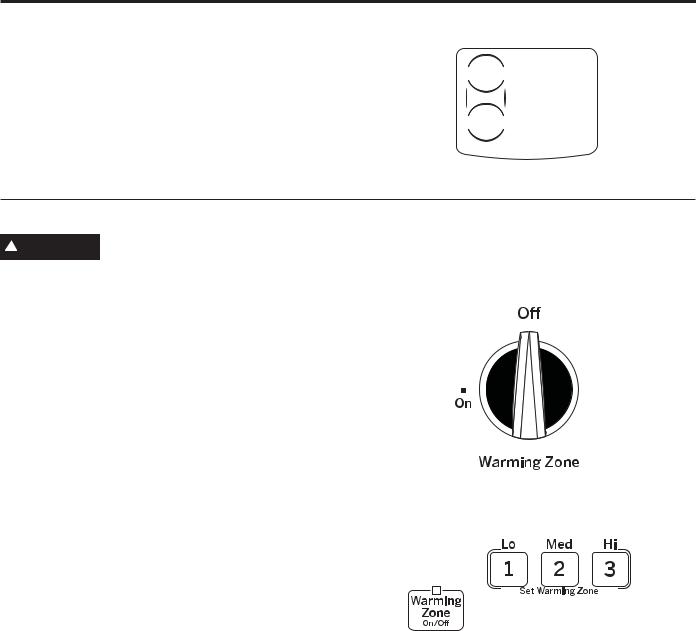
Surface Units (Cont.)
Throughout this manual, features and appearance may vary from your model.
Using the Bridge Zone (on some models)
To use the bridge zone, adjust the knobs for the Left rear and Left front elements to create one large area for even cooking.
Models with a bridge Zone only.
Using the Warming Zone
 WARNING FOOD POISON HAZARD: Bacteria may grow in food at temperatures below 140°F.
WARNING FOOD POISON HAZARD: Bacteria may grow in food at temperatures below 140°F.
Ŷ $OZD\V VWDUW ZLWK KRW IRRG 'R QRW XVH ZDUP VHWWLQJ WR KHDW FROG IRRG Ŷ 'R QRW XVH ZDUP VHWWLQJ IRU PRUH WKDQ KRXUV
The WARMING ZONE, located in the back center of
the glass surface, will keep hot, cooked food at serving
WHPSHUDWXUH $OZD\V VWDUW ZLWK KRW IRRG 'R QRW XVH WR heat cold food. Placing uncooked or cold food on the WARMING ZONE could result in foodborne illness.
Turn the control knob to the ON position.
For models using the touch pads for warming zone control,
VHH VHFWLRQ RQ 8VLQJ WKH 2YHQ IRU DGGLWLRQDO GHWDLOV
For best results, all foods on the WARMING ZONE should be covered with a lid or aluminum foil. When warming pastries or breads, the cover should be vented to allow moisture to escape.
The initial temperature, type and amount of food, type of pan, and the time held will affect the quality of the food.
Always use pot holders or oven mitts when removing food from the WARMING ZONE, since cookware and
plates will be hot.
NOTE: The surface warmer will not glow red like the cooking elements.
8QLWV6XUIDFHRANGE: THE USING
49-80690-5 |
9 |
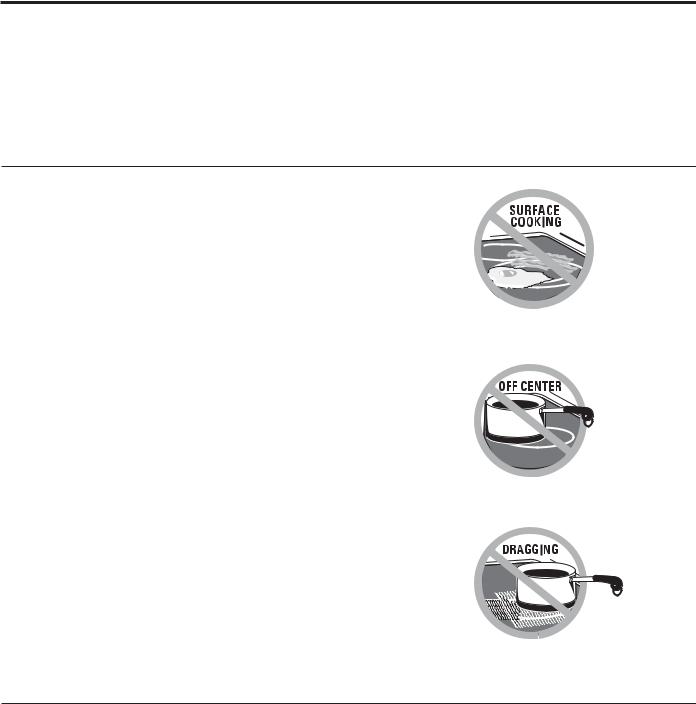
USING THE RANGE:6XUIDFH8QLWV
Surface Units (Cont.)
Home Canning Tips
Be sure the canner is centered over the surface unit. Make sure the canner is flat on the bottom.
To prevent burns from steam or heat, use caution when canning.
8VH UHFLSHV DQG SURFHGXUHV IURP UHSXWDEOH VRXUFHV
These are available from manufacturers such as Ball® and Kerr® DQG WKH 'HSDUWPHQW RI $JULFXOWXUH ([WHQVLRQ
Service.
)ODW ERWWRPHG FDQQHUV DUH UHFRPPHQGHG 8VH RI ZDWHU bath canners with rippled bottoms may extend the time required to bring the water to a boil.
For Models With a Radiant Glass Cooktop
The radiant cooktop features heating units beneath a smooth glass surface.
NOTE: A slight odor is normal when a new cooktop is used for the first time. It is caused by the heating of new parts and insulating materials and will disappear in a short time.
NOTE: On models with light-colored glass cooktops, it is normal for the cooking zones to change color when hot or cooling down. This is temporary and will disappear as the glass cools to room temperature.
The surface unit will cycle on and off to maintain your selected control setting.
It is safe to place hot cookware on the glass surface even when the cooktop is cool.
Even after the surface units are turned off, the glass cooktop retains enough heat to continue cooking. To avoid overcooking, remove pans from the surface units when the food is cooked. Avoid placing anything on the surface unit until it has cooled completely.
Ŷ :DWHU VWDLQV PLQHUDO GHSRVLWV DUH UHPRYDEOH XVLQJ the cleaning cream or full-strength white vinegar.
Ŷ 8VH RI ZLQGRZ FOHDQHU PD\ OHDYH DQ LULGHVFHQW ILOP RQ the cooktop. The cleaning cream will remove this film.
Ŷ 'RQ¶W VWRUH KHDY\ LWHPV DERYH WKH FRRNWRS ,I WKH\ drop onto the cooktop, they can cause damage.
Ŷ 'R QRW XVH WKH VXUIDFH DV D FXWWLQJ ERDUG
Never cook directly on the glass.
Always use cookware.
Always place the pan in the center of the surface unit you are cooking on.
'R QRW VOLGH FRRNZDUH DFURVV WKH FRRNWRS EHFDXVH
LW FDQ VFUDWFK WKH JODVV WKH JODVV LV VFUDWFK resistant, not scratch proof.
Temperature Limiter on Radiant Glass Cooktops
Every radiant surface unit has a temperature limiter.
The temperature limiter protects the glass cooktop from getting too hot.
The temperature limiter may cycle the surface units off for a time if:
Ŷ WKH SDQ ERLOV GU\
Ŷ WKH SDQ ERWWRP LV QRW IODW
Ŷ WKH SDQ LV RII FHQWHU
Ŷ WKHUH LV QR SDQ RQ WKH XQLW
10 |
49-80690-5 |
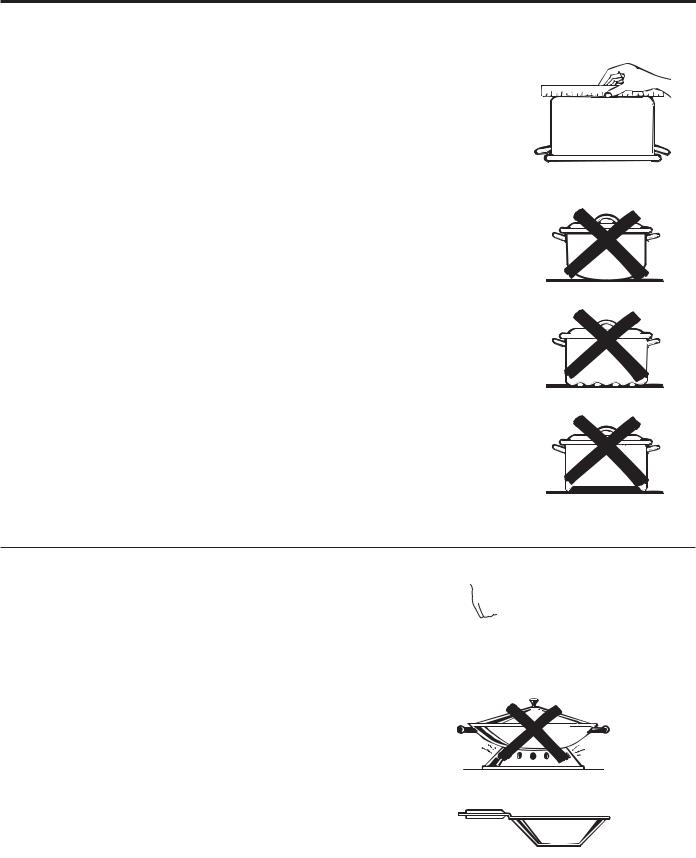
Cookware for Radiant Glass Cooktop
The following information will help you choose cookware which will give good performance on glass cooktops.
NOTE: Follow all cookware manufacturer’s recommendations when using any type of cookware on the ceramic cooktop.
Recommended
Stainless Steel
Aluminum:
heavy weight recommended
Good conductivity. Aluminum residues sometimes appear as scratches on the cooktop but can be removed if cleaned immediately. Because of its low melting point, thin weight aluminum should not be used.
Copper Bottom:
Copper may leave residues which can appear as scratches. The residues can be removed, as long as the cooktop
is cleaned immediately. However, do not let these pots boil dry. Overheated metal can bond to glass cooktops. An overheated copper bottom pot will leave a residue that will permanently stain the cooktop if not removed immediately.
Enamel (painted) on Cast Iron:
recommended if bottom of pan is coated
Avoid/Not Recommended
Enamel (painted) on Steel:
Heating empty pans can cause permanent damage to cooktop glass. The enamel can melt and bond to the ceramic cooktop.
Glass-ceramic:
Poor performance. Will scratch the surface.
Stoneware:
Poor performance. May scratch the surface.
Cast Iron:
QRW UHFRPPHQGHG XQOHVV GHVLJQHG specifically for glass cooktops
Poor conductivity and slow to absorb heat. Will scratch the cooktop surface.
Check pans for flat bottoms by using a straight edge.
Pans with rounded, curved, ridged or warped bottoms are not recommended.
For Best Results
Ŷ 3ODFH RQO\ GU\ SDQV RQ WKH VXUIDFH HOHPHQWV 'R QRW place lids on the surface elements, particularly wet lids. Wet pans and lids may stick to the surface when cool.
Ŷ 'R QRW XVH ZRNV WKDW KDYH VXSSRUW ULQJV 7KLV W\SH RI wok will not heat on glass surface elements.
Ŷ :H UHFRPPHQG WKDW \RX XVH RQO\ D IODW ERWWRPHG wok. They are available at your local retail store. The bottom of the wok should have the same diameter as the surface element to ensure proper contact.
Ŷ 6RPH VSHFLDO FRRNLQJ SURFHGXUHV UHTXLUH VSHFLILF cookware such as pressure cookers or deep-fat fryers. All cookware must have flat bottoms and be the correct size.
'R QRW SODFH ZHW SDQV RQ WKH JODVV FRRNWRS
'R QRW XVH ZRNV ZLWK VXSSRUW ULQJV RQ WKH JODVV FRRNWRS
8VH IODW ERWWRPHG ZRNV RQ WKH JODVV FRRNWRS
Cooktop Glass Radiant for Cookware RANGE: THE USING
49-80690-5 |
11 |
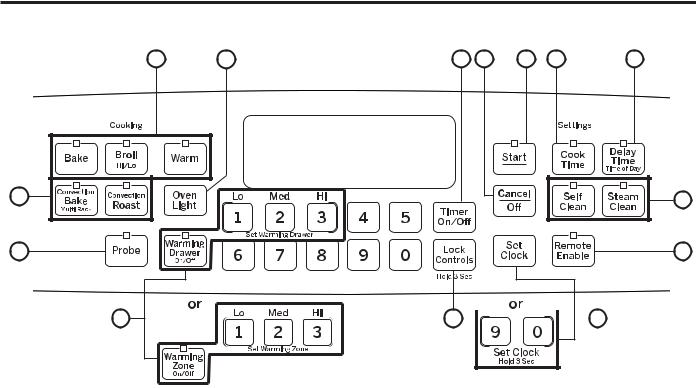
USING THE RANGE: Oven Controls
Oven Controls
2 10
1 |
13
(on some models)
12
8 |
5 |
4 |
6 |
9 |
3
14
(on some models)
11 
 7
7
12 |
49-80690-5 |

Oven Controls
1. Convection Cooking Modes: Convection
cooking modes use increased air circulation to improve performance. The type of benefit depends on the mode. Your oven has the following convection cooking modes: Convection Bake and Convection Roast. See the Cooking Modes section for more information.
2. Traditional Cooking Modes: Your oven has
WKH IROORZLQJ WUDGLWLRQDO FRRNLQJ PRGHV %DNH %URLO +L
Lo, and Warm. See the Cooking Modes section for more information.
3. Clean: Your oven has two cleaning modes: Self Clean and Steam Clean. See the Cleaning the Oven section for important information about using these modes.
4. Start: Must be pressed to start any cooking, cleaning, or timed function.
5. Cancel/Off: Cancels ALL oven operations except
WKH FORFN WLPHU :DUPLQJ 'UDZHU DQG :DUPLQJ =RQH
6. Cook Time: Counts down cooking time and turns off the oven when the cooking time is complete. Press the Cook Time pad, use the number pads to program a cooking time in hours and minutes, then press Start. This can only be used with Bake, Convection Bake, and Convection Roast.
7. Clock: Sets the oven clock time. Press and hold the 9, 0 pads for three seconds or press the Set Clock pad, then use the number pads to program the clock. Press Start to save the time.
8. Timer On/Off: Works as a countdown timer. Press the Timer On/Off pad and the number pads to program the time in hours and minutes. Press the Start pad. The timer countdown is complete. To turn the timer off press the Timer On/Off pad.
9. Delay Time: 'HOD\V ZKHQ WKH RYHQ ZLOO WXUQ RQ
8VH WKLV WR VHW D WLPH ZKHQ \RX ZDQW WKH RYHQ WR VWDUW
Press the Delay Time pad and use the number pads to program the time of day for the oven to turn on then press Start. Press the desired cooking mode and temperature then press Start. A Cook Time may also be programmed if desired. Follow the directions under Cook Time for setting this feature. This can only be used with Bake, Convection Bake, Convection Roast, and Self-Clean.
NOTE: :KHQ XVLQJ WKH 'HOD\ 7LPH IHDWXUH foods that VSRLO HDVLO\ VXFK DV PLON HJJV ILVK VWXIILQJV SRXOWU\
DQG SRUN VKRXOG QRW EH DOORZHG WR VLW IRU PRUH WKDQ
1 hour before or after cooking. Room temperature promotes the growth of harmful bacteria. Be sure that the oven light is off because heat from the bulb will speed harmful bacteria growth.
10. Oven Light: Turns the oven light on or off.
11. Lock Controls: Locks out the control so that pressing the pads does not activate the controls. Press the Lock Controls pad, for three seconds to lock or unlock the control. Cancel/Off is always active, even when the control is locked.
12. Warming Drawer (on some models) or
Warming Zone: Will keep hot, cooked foods at serving temperature. Press the Warming Drawer/ Warming Zone SDG 8VH WKH QXPEHU SDG WR VHOHFW WKH temperature setting. Press 1 for Low, 2 for Medium
or 3 for High, then press Start 'UDZHU LV EHORZ WKH
Oven, Zone is on the Cooktop.
NOTE: 7KH &DQFHO 2II SDG GRHV QRW WXUQ RII WKH
:DUPLQJ 'UDZHU RU :DUPLQJ =RQH 7R WXUQ RII SUHVV the Warming Drawer or Warming Zone pad.
13. Probe (on some models): Monitors internal
food temperature and turns the oven off when the food reaches the programmed temperature. Insert the probe, program the cooking mode, and program the probe temperature. See the Cooking Modes section for more information. The probe can only be used with Bake and Convection Roast.
14. Remote Enable (on some models): The
oven needs to be connected to your home network before using the Remote Enable pad. The connectivity symbol signifies the status of the oven connection to your home network.
CONNECTING YOUR OVEN
Off - Oven is not connected. Open the app then press and hold Remote Enable pad for 5 seconds to begin the connecting process.
Slow flash - Oven is in discovery mode and looking for a network.
Solid - Oven is connected to the network and can be remotely controlled by a connected mobile device when in operation, but cannot be started remotely.
REMOTE STARTING YOUR OVEN
To be able to start the oven remotely, press the Remote Enable pad and the light above the Remote Enable pad will turn on. Oven can now be remotely started with a connected device. Opening oven door or turning off oven will turn off the light above the Remote Enable pad. The light above the Remote Enable pad must be lit to start the oven remotely. The light above the Remote Enable pad is not required to change the oven settings or to turn oven off.
After using the oven, remember to verify that the light above the Remote Enable pad is on if you wish to start an oven remotely in the future.
Controls Oven RANGE: THE USING
49-80690-5 |
13 |

USING THE RANGE: Special Features
Special Features
There are several different special features on your range. To change the settings of these special features: Ŷ 3UHVV WKH Bake and Broil pads at the same time and hold for three seconds.
Ŷ ³6)´ ZLOO DSSHDU LQ WKH GLVSOD\
Ŷ 6HOHFW WKH IHDWXUH \RX ZDQW WR FKDQJH
Ŷ :KHQ WKH FKDQJH KDV EHHQ PDGH SUHVV WKH Start key to save the change and return to the time of day.
Adjust the Oven Temperature
This feature allows the oven baking and convection baking temperature to be adjusted up to 35ºF hotter
RU GRZQ WR ) FRROHU 8VH WKLV IHDWXUH LI \RX EHOLHYH your oven temperature is too hot or too cold and wish to change it. This adjustment affects Bake and Convection Bake modes. No other cooking modes are affected.
Press the Bake pad to enter the temperature adjustment mode. A number between 35 and - 35 will display.
8VH WKH QXPEHU SDGV WR VHW WKH GHVLUHG WHPSHUDWXUH adjustment and use the Bake pad to change between negative and positive. Press the Start pad to save the temperature adjustment.
End of Timer Signals
This is the tone that signals the end of a timer. The tone can be continuous (Con bEEP) or one repeating beep (bEEP). A continuous setting will continue to sound a tone until a button on the control is pressed. Press the Broil pad to view the current setting and then to change the setting.
Fahrenheit or Celsius Temperature Display
The oven control is set to use Fahrenheit temperatures (F), but you can change it to use Celsius temperatures
(C). Press the number 6 and 8 pads at the same time to view the current setting, press again to change the setting.
Clock Display
This feature specifies how the time of day will be displayed or if no time of day will be displayed. You can select a standard 12-hour clock (12 H), 24-hour military time display (24 H), or no clock displayed (oFF). Press the Clock pad to view the current setting, press again to change the setting.
Auto Recipe Conversion
When using Convection Bake cooking, Auto Recipe Conversion will automatically convert the regular baking temperatures entered to convection bake cooking temperatures when turned on. Note that this option does not convert convection bake cooking times, it only converts temperatures. Press the Convection Bake pad to view the conversion settings, press again to toggle between On (Con On) and Off (Con oFF).
Sound Volume
This feature allows the oven tone volume to be adjusted between high (HI bEEP HI), medium (Std bEEP Std), low (Lo bEEP Lo) and off (oFF bEEP oFF). Press the number 1 and 5 pads at the same time to view the current setting or to change the setting. The control will sound the oven tone at the new volume level each time the sound level is changed.
Preheat Notification Lighting (on some models)
This feature will turn on the oven light when the oven has reached the set temperature. The oven light will remain on until the Oven Light pad is pushed. Press the Oven Light pad to view the current setting, press again to change the setting.
12-hour auto shut-off and Sabbath
2SWLRQV IRU WKLV IHDWXUH DUH ³ 6+GQ´ ³QR 6+GQ´ DQG
³6$EE$W+´
12-hour auto shut-off turns off the oven after 12 hours of continuous operations.
Sabbath mode disables all sounds (the control will not beep when a button is pressed), Convection, Broil, Warm,
&RRN 7LPH 7LPHU &ORFN DQG 'HOD\ 7LPH IXQFWLRQV
Sabbath mode can only be used with Bake. This feature conforms to the Star-K Jewish Sabbath requirements. NOTE: The oven light comes on automatically (on some models) when the door is opened and goes off when the door is closed. The bulb may be removed. See the Oven Light Replacement section. On models with a light switch on the control panel, the oven light may be turned on and left on.
Press the Delay Time pad to view the current setting and then to change the setting.
7R XVH 6DEEDWK PRGH VHOHFW ³6$EE$W+´ DQG SUHVV Start. A ] will appear in the display and the clock will not display. Once in Sabbath mode, at any time you can press Bake, use the number pads to enter a temperature between 170ºF and 550ºF, and press Start. No sound will be given when the keys are pressed. At a random time between 30 seconds and 1 minute, ][, will appear in the display indicating the oven is running.
If you need to adjust the temperature, press Bake, use the number pads to enter a new temperature between 170ºF and 550ºF, and press Start.
To exit Sabbath mode, make sure that the oven is turned off. To turn the oven off, press Cancel/Off. The oven will immediately turn off and ][ will change to ] indicating that the oven has turned off. Press and hold the Bake and Broil pads for 3 seconds to enter special features then press Delay Time until either "12 Shdn" or "no Shdn" is in the display and press Start.
NOTE: If power outage occurs during Sabbath mode the unit will remain in Sabbath mode but off when power is restored.
If you wish to use the Cook Time feature (if available) to bake in the oven and then have the oven automatically turn off, you will need to press the Cook Time pad, enter a cooking time duration, and press Start. Then enter special features to start Sabbath mode as detailed above.
14 |
49-80690-5 |
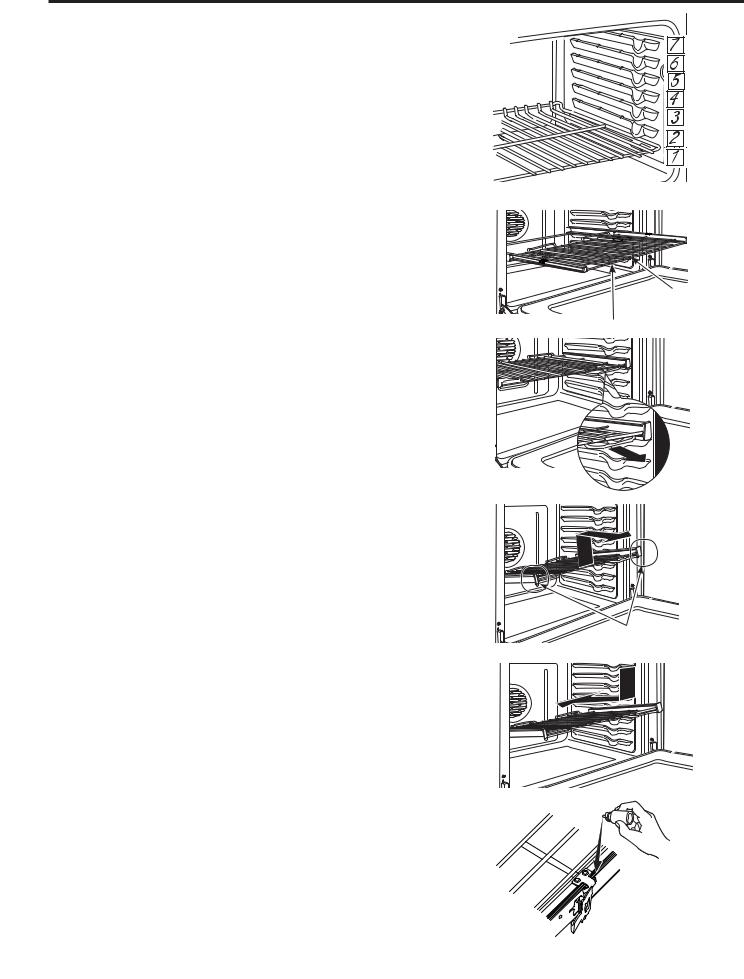
Oven Racks
Recommended rack positions for various types of foods are provided in the Cooking Guide. Adjusting rack position is one way to impact cooking results. For example, if you would prefer darker tops on cakes, muffins, or cookies, try moving food one rack position higher. If you find foods are too brown on top try moving them down next time.
When baking with multiple pans and on multiple racks, ensure there is at least 1½" between pans to allow sufficient space for air to flow.
<RXU 2YHQ PD\ KDYH H[WHQVLRQ UDFNV DQG RU WUDGLWLRQDO flat racks.
To avoid possible burns, place the racks in the desired position before you turn the oven on.
Extension Racks
Always pull the rack out by its upper front rail to its fully open position, when placing or removing cookware.
If extension racks are difficult to extend, lubricate the racks with the graphite lubricant provided with your oven. Remove the rack from the oven, remove debris in the side tracks with a paper towel, shake the graphite lubricant and place 4 small drops on the two bottom tracks of the left and right sides. Open and close the rack several times to distribute the lubricant.
To order additional graphite lubricant, read the Assistance and Accessories section at the beginning of the manual.
To Remove An Extension Rack:
1.Make sure the rack is pushed all the way into the oven so that side paddles on the rack disengage from the oven support.
2.Slide the rack toward you to the bump (stop position) on the rack support.
3.Firmly grasp both sides of the rack frame and the sliding rack, tilt the front end up and pull it out.
To Replace An Extension Rack:
1.Firmly grasp both sides of the rack frame and the sliding rack.
2.Place the curved end of the rack (stop-locks) onto the oven supports, tilt up the front of the rack and push it in as far as it will go.
If extension racks are difficult to replace or remove, wipe
WKH RYHQ UDFN VXSSRUWV ZLWK FRRNLQJ RLO 'R QRW ZLSH RLO on the rack slides.
To Lubricate the Paddle:
Shake lubricant and apply to the moving parts of the paddle mechanisms as shown.
The number of rack positions may vary by model.
8SSHU )URQW
Rail
Fully Open Position
Grasp here
Racks Oven RANGE: THE USING
49-80690-5 |
15 |
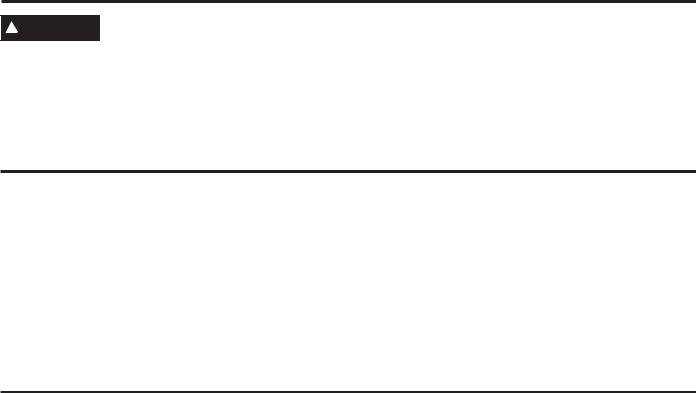
USING THE RANGE: Aluminum Foil and Oven Liners &RRNZDUH&RRNLQJ0RGHV
Aluminum Foil and Oven Liners

 CAUTION Do not use any type of foil or oven liner to cover the oven bottom. These items can trap heat or melt, resulting in damage to the product and risk of shock, smoke or fire. Damage from improper use of these items is not covered by the product warranty.
CAUTION Do not use any type of foil or oven liner to cover the oven bottom. These items can trap heat or melt, resulting in damage to the product and risk of shock, smoke or fire. Damage from improper use of these items is not covered by the product warranty.
)RLO PD\ EH XVHG WR FDWFK VSLOOV E\ SODFLQJ D VKHHW RQ D ORZHU UDFN VHYHUDO LQFKHV EHORZ WKH IRRG 'R QRW XVH PRUH
IRLO WKDQ QHFHVVDU\ DQG QHYHU HQWLUHO\ FRYHU DQ RYHQ UDFN ZLWK DOXPLQXP IRLO .HHS IRLO DW OHDVW ´ IURP RYHQ ZDOOV to prevent poor heat circulation.
Cookware
Cookware Guidelines
The material, finish, and size of cookware affect baking performance.
'DUN FRDWHG DQG GXOO SDQV DEVRUE KHDW PRUH UHDGLO\ than light, shiny pans. Pans that absorb heat more readily can result in a browner, crisper, and thicker crust. If using dark and coated cookware check food earlier than minimum cook time. If undesirable results are obtained with this type of cookware consider reducing oven temperature by 25º F next time.
Shiny pans can produce more evenly cooked baked goods such as cakes and cookies.
Glass and ceramic pans heat slowly but retain heat well. These types of pans work well for dishes such as pies and custards.
Air insulated pans heat slowly and can reduce bottom browning.
Keep cookware clean to promote even heating.
Cooking Modes
Your new oven has a variety of cooking modes to help you get the best results. These modes are described below. Refer to the Cooking Guide section for recommendations for specific foods. Remember, your new oven may perform differently than the oven it is replacing.
Baking and Roasting Modes
Select a mode for baking and roasting based on the type and quantity of food you are preparing. When preparing baked goods such as cakes, cookies, and pastries always preheat the oven first. Follow recipe recommendations for food placement. If no guidelines are provided, center food in the oven.
Bake
The bake mode is intended for single rack cooking. This mode uses heat primarily from the lower element but also from the upper element to cook food. To use this mode press the Bake pad, enter a temperature, and then press Start. Preheating is generally recommended when using this mode.
Convection Bake Multi Rack
The Convection Bake Multi Rack mode is intended for baking on multiple racks at the same time. This mode uses heat primarily from the rear element but also heat from the upper and lower elements, along with air movement from the convection fan to enhance cooking evenness. Your oven is equipped with Auto
Recipe Conversion, so it is not necessary to convert the temperature when using this mode. Baking time might be slightly longer for multiple racks than what would be expected for a single rack. To use this mode press the Convection Bake pad, enter a temperature, and then press Start. Always preheat when using this mode.
Convection Roast
The Convection Roast mode is intended for roasting whole cuts of meat on a single rack. This mode uses heat from the lower, upper, and rear elements along with air movement from the convection fan to improve browning and reduce cooking time. It is not necessary to convert temperature. Check food earlier than the recipe suggested time when using this mode or use a meat probe. To use this mode press the Convection Roast pad, enter a temperature, and then press Start. It is not necessary to preheat when using this mode.
Broiling Modes
Always broil with the door open. Monitor food closely
ZKLOH EURLOLQJ 8VH FDXWLRQ ZKHQ EURLOLQJ RQ XSSHU UDFN positions as placing food closer to the broil element increases smoking, spattering, and the possibility of fats igniting. For best performance center food below the broil heating element. Broiling on the upper most rack position is not recommended.
Try broiling foods that you would normally grill. Adjust rack positions to adjust the intensity of the heat to the food. Place foods closer to the broil element when a seared surface and rare interior is desired. Thicker foods and foods that need to be cooked through should be broiled on a rack position farther from the broiler or by using Broil Lo.
16 |
49-80690-5 |

Cooking Modes (Cont.)
Broil Hi
The Broil Hi mode uses intense heat from the upper
HOHPHQW WR VHDU IRRGV 8VH %URLO +L IRU WKLQQHU FXWV RI PHDW
DQG RU IRRGV \RX SUHIHU OHVV GRQH RQ WKH LQWHULRU 7R XVH this mode press the Broil pad once and then press Start. It is not necessary to preheat when using this mode.
Broil Lo
The Broil Lo mode uses less intense heat from the upper element to cook food thoroughly while also producing
VXUIDFH EURZQLQJ 8VH %URLO /R IRU WKLFNHU FXWV RI PHDW
DQG RU IRRGV WKDW \RX ZRXOG OLNH FRRNHG DOO WKH ZD\ through. To use this mode press the Broil pad twice and then press Start. It is not necessary to preheat when using this mode.
Warm
Warm mode is designed to keep hot food hot, it is not intended to heat cold food. To use this mode, press the Warm pad then press Start. Preheating is not required. Cover foods that need to remain moist and do not cover foods that should be crisp. Warm can be used for crisping crackers, chips or dry cereal. It is recommended, for food quality, that food not be kept warm for more than 2 hours.
Probe (on some models)
Internal food temperature is frequently used as an indicator of doneness, especially for roasts and poultry. The Probe mode monitors the internal food temperature and turns the oven off when the internal food temperature reaches the programmed temperature.
Minimum temperatures for food safety can be found at
ZZZ ,V,W'RQH<HW JRY 7KH WHPSHUDWXUH SUREH FDQ RQO\ be used with Bake, Convection Bake, and Convection Roast modes.
To use the probe with preheating:
1.Press the desired cook mode (Bake, Convection Bake, or Convection Roast) pad and enter the desired cooking temperature.
2.Insert the probe into the food (see Proper Probe Placement Guidelines in this section).
3.Once the oven is preheated, place the food in the oven and connect the probe to the probe outlet,
PDNLQJ VXUH LW LV IXOO\ LQVHUWHG 8VH FDXWLRQ WKH RYHQ walls and probe outlet are hot.
4.Program the probe temperature by pressing the Probe pad and entering the desired food
temperature. The maximum internal food temperature that you can set is 200º F.
To use the probe without preheating:
1.Insert the probe into the food (see Proper Probe Placement Guidelines in this section).
2.Place the food in the oven and connect the probe into the probe outlet in the oven.
3.Program the desired probe and cooking mode settings by pressing the Probe pad and entering the desired food temperature, then pressing the cook mode pad (Bake, Convection Bake, or Convection Roast) and entering the desired cooking temperature.
Proper Probe Placement Guidelines
After preparing the meat and placing it on the cooking pan follow these guidelines for proper probe placement.
Ŷ ,QVHUW WKH SUREH FRPSOHWHO\ LQWR WKH PHDW XS WR WKH handle, such that the point of the probe will rest in the center of the thickest part of the meat.
Ŷ 7KH SUREH VKRXOG QRW WRXFK ERQH IDW RU JULVWOH
Ŷ )RU ZKROH SRXOWU\ LQVHUW WKH SUREH LQWR WKH WKLFNHVW part of the breast.
Ŷ )RU ERQHOHVV URDVWV LQVHUW WKH SUREH LQWR WKH FHQWHU of the roast.
Ŷ )RU ERQH LQ KDP RU ODPE LQVHUW WKH SUREH LQWR WKH center of the lowest large muscle or joint.
Ŷ )RU FDVVHUROHV RU GLVKHV VXFK DV PHDWORDI LQVHUW WKH probe into the center of the dish.
Ŷ )RU ILVK LQVHUW WKH SUREH IURP MXVW DERYH WKH JLOO LQWR the meatiest area, parallel to the backbone.
Check the temperature at other locations in the food with a food thermometer once the probe temperature is reached to ensure that all portions of the food have reached desired temperatures.
Probe Care Guidelines
Ŷ 8VH RI SUREHV RWKHU WKDQ WKH RQH SURYLGHG ZLWK WKLV product may result in damage to the probe.
Ŷ 8VH WKH KDQGOHV RI WKH SUREH DQG SOXJ ZKHQ LQVHUWLQJ and removing them from the meat and outlet
Ŷ 7R DYRLG GDPDJLQJ \RXU SUREH GR QRW XVH WRQJV WR pull on the cable when removing it.
Ŷ 7R DYRLG EUHDNLQJ WKH SUREH PDNH VXUH IRRG LV completely defrosted before inserting the probe.
Ŷ 7R SUHYHQW SRVVLEOH EXUQV GR QRW XQSOXJ WKH SUREH from the outlet until the oven has cooled.
Ŷ 1HYHU OHDYH WKH SUREH LQVLGH WKH RYHQ GXULQJ D VHOI RU steam clean cycle.
Ŷ 'R QRW VWRUH WKH SUREH LQ WKH RYHQ
Modes Cooking RANGE: THE USING
49-80690-5 |
17 |
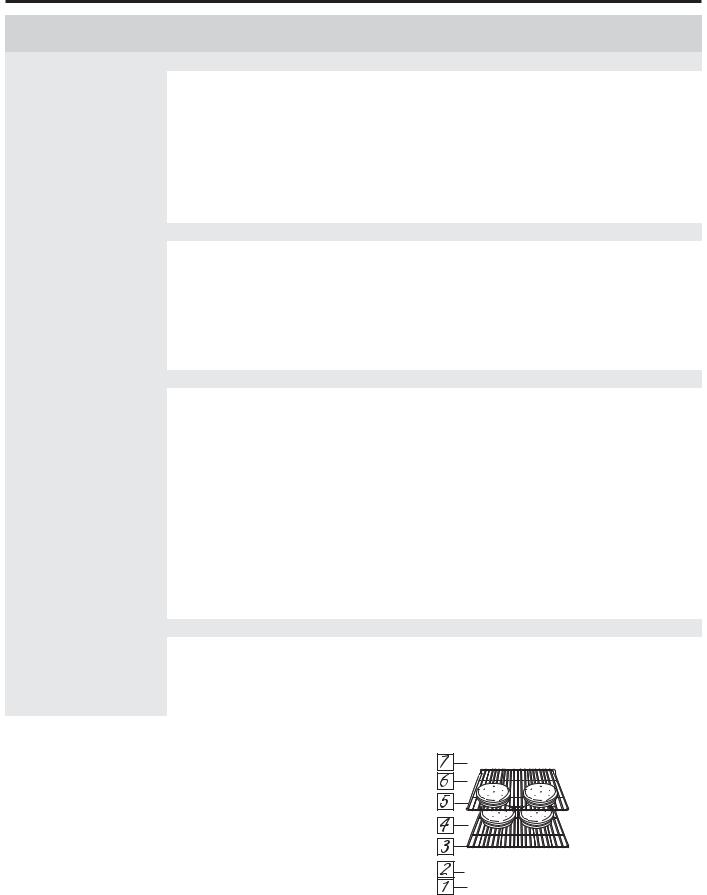
USING THE RANGE: Cooking Guide
Cooking Guide
|
RECOMMENDED |
RECOMMENDED |
|
|
FOOD TYPE |
MODE(S) |
RACK POSITION(S) |
ADDITIONAL SUGGESTIONS |
|
Baked Goods |
|
|
|
|
|
|
|
|
|
Layer Cakes, sheet cakes, bundt |
|
|
|
|
cakes, muffins, quick breads on |
Bake |
4 |
8VH VKLQ\ FRRNZDUH |
|
a Single Rack |
|
|
|
|
Layer cakes* on Multiple Racks |
Bake |
3 and 5 |
Ensure adequate airflow |
|
(see illustration below). |
||||
|
|
|
||
Chiffon cakes (angel food) |
Bake |
1 |
8VH VKLQ\ FRRNZDUH |
|
|
|
|
|
|
Cookies, biscuits, scones on a |
Bake |
4 |
8VH VKLQ\ FRRNZDUH |
|
Single Rack |
||||
|
|
|
||
|
|
|
|
|
Cookies, biscuits, scones on |
Bake |
3 and 5 |
|
|
2, 4, and 6 (3 rack recommended |
Ensure adequate airflow. |
|||
Multiple Racks |
Convection Bake (if available) |
|||
only for Convection Bake) |
|
|||
|
|
|
||
|
|
|
|
|
Beef & Pork |
|
|
|
|
|
|
|
|
|
|
|
|
8VH D EURLO SDQ PRYH IRRG GRZQ IRU PRUH GRQH- |
|
Hamburgers |
Broil Hi |
6 |
QHVV OHVV VHDULQJ :DWFK IRRG FORVHO\ ZKHQ EURLOLQJ |
|
For best performance center food below the broil |
||||
|
|
|
||
|
|
|
heating element |
|
|
|
|
|
|
|
|
|
8VH D EURLO SDQ PRYH IRRG GRZQ IRU PRUH GRQH- |
|
Steaks & Chops |
Broil Hi |
6 |
QHVV OHVV VHDULQJ :DWFK IRRG FORVHO\ ZKHQ EURLOLQJ |
|
For best performance center food below the broil |
||||
|
|
|
||
|
|
|
heating element |
|
|
|
|
|
|
Roasts |
Bake |
3 or 4 |
8VH D ORZ VLGHG SDQ VXFK DV D EURLO SDQ 3UHKHDWLQJ |
|
Convection Roast (if available) |
is not necessary |
|||
|
|
|||
|
|
|
|
|
Poultry |
|
|
|
|
|
|
|
|
|
Whole chicken |
Bake |
3 or 4 |
8VH D ORZ VLGHG SDQ VXFK DV D EURLO SDQ |
|
Convection Roast (if available) |
||||
|
|
|
||
|
|
|
|
|
|
Broil Hi |
2 |
If breaded or coated in sauce avoid Broil Hi modes. |
|
Bone-in chicken breasts, legs, |
|
|
Broil skin side down first. Watch food closely when |
|
Broil Lo |
|
|||
thighs |
2 or 3 |
broiling. For best performance when broiling, center |
||
|
Bake |
|
food below the broil heating element. |
|
|
|
|
|
|
|
|
|
If breaded or coated in sauce avoid Broil Hi modes. |
|
Boneless chicken breasts |
Broil Lo |
2 or 3 |
Broil skin side down first. Watch food closely when |
|
Bake |
broiling. For best performance when broiling, center |
|||
|
|
|||
|
|
|
food below the broil heating element |
|
|
|
|
|
|
Whole turkey |
Bake |
2 or 3 |
8VH D ORZ VLGHG SDQ VXFK DV D EURLO SDQ |
|
Convection Roast (if available) |
||||
|
|
|
||
Turkey Breast |
Bake |
2 or 3 |
8VH D ORZ VLGHG SDQ VXFK DV D EURLO SDQ |
|
Convection Roast (if available) |
||||
|
|
|
||
|
|
|
|
|
Fish |
Broil Lo |
WKLFN RU OHVV |
Watch food closely when broiling. For best perfor- |
|
! LQFK |
mance center food below the broil heating element. |
|||
|
|
|||
Casseroles |
Bake |
4 |
|
|
Frozen Convenience Foods |
|
|
|
|
Pizza, french fries, tator tots, |
|
|
|
|
chicken nuggets, appetizers on a |
Bake |
4 |
8VH VKLQ\ FRRNZDUH |
|
Single Rack |
|
|
|
|
|
|
|
|
|
Pizza, french fries, tator tots, |
Bake |
|
|
|
chicken nuggets, appetizers on |
3 and 5 |
8VH VKLQ\ FRRNZDUH |
||
Convection Bake (if available) |
||||
Multiple Racks |
|
|
||
|
|
|
||
|
|
|
|
*When baking four cake layers at a time, use racks 3 and 5. Place the pans as shown so that one pan is not directly above another.
Cook food thoroughly to help protect against food borne illness. Minimum safe food temperature recommendations for food safety can be found at www.IsItDoneYet.gov. Make sure to use a food thermometer to take food temperatures.
Rack position for baking 4 layer cakes.
18 |
49-80690-5 |

Warming Drawer (on some models)
When Using the Warming Drawer
The warming drawer will keep hot, cooked foods warm.
$OZD\V VWDUW ZLWK KRW IRRG 'R QRW XVH WR KHDW FROG IRRG other than crisping crackers, chips or dry cereal.
Do not line the warming drawer or pan with aluminum foil. Foil is an excellent heat insulator and will trap heat beneath it. This will upset the performance of the drawer and could damage the interior finish.
Allow approximately 25 minutes for the warming drawer to preheat.
Ŷ 'R QRW SXW OLTXLG RU ZDWHU LQ WKH ZDUPLQJ GUDZHU
Ŷ $OO IRRGV SODFHG LQ WKH ZDUPLQJ GUDZHU VKRXOG EH covered with a lid or aluminum foil. When warming pastries or breads, the cover should be vented to allow moisture to escape.
Ŷ )RRG VKRXOG EH NHSW KRW LQ LWV FRRNLQJ FRQWDLQHU RU transferred to a heat-safe serving dish.
NOTE: Plastic containers or plastic wrap will melt if in direct contact with the drawer, pan or a hot utensil.
Melted plastic may not be removable and is not covered under your warranty.
Ŷ 5HPRYH VHUYLQJ VSRRQV HWF EHIRUH SODFLQJ containers in warming drawer.
Temperature Selection Chart
To keep several different foods hot, set the control to the food needing the highest setting.
Ŷ 7KH WHPSHUDWXUH W\SH DQG DPRXQW RI IRRG DQG WKH time held will affect the quality of the food.
Ŷ 5HSHDWHG RSHQLQJ RI WKH GUDZHU DOORZV WKH KRW DLU WR escape and the food to cool.
Ŷ :LWK ODUJH ORDGV LW PD\ EH QHFHVVDU\ WR XVH D KLJKHU warming drawer setting and cover some of the cooked food items.
Ŷ 'R QRW XVH SODVWLF FRQWDLQHUV RU SODVWLF ZUDS
Food Type |
Control Setting |
Casserole |
0(' |
Chili |
+, |
Pizza |
0(' |
Potatoes, baked |
+, |
Tortilla Chips |
/2 |
Waffles |
/2 |
|
|
To Crisp Stale Items
Ŷ |
3ODFH IRRG LQ ORZ VLGHG GLVKHV RU SDQV |
Ŷ &KHFN FULVSQHVV DIWHU PLQXWHV $GG WLPH DV QHHGHG |
Ŷ |
3UHKHDW RQ LO/1 setting. |
|
To Warm Serving Bowls and Plates

 CAUTION 'LVKHV ZLOO EH KRW 8VH SRW KROGHUV RU mitts when removing hot dishes.
CAUTION 'LVKHV ZLOO EH KRW 8VH SRW KROGHUV RU mitts when removing hot dishes.
To warm serving bowls and plates, set the control on LO/1.
Ŷ 8VH RQO\ KHDW VDIH GLVKHV
ŶIf you want to heat fine china, please check with the manufacturer of the dishes for their maximum heat tolerance.
ŶYou may warm empty serving dishes while preheating the drawer.
'UDZHU:DUPLQJRANGE: THE USING
49-80690-5 |
19 |
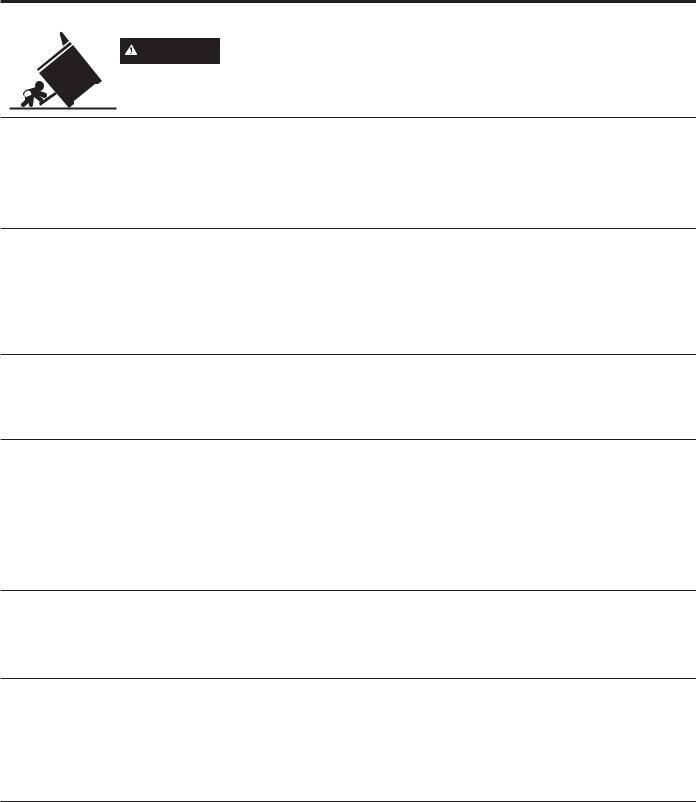
CARE AND CLEANING: Cleaning the Range – Exterior
Cleaning the Range – Exterior
Be sure all controls are off and all surfaces are cool before cleaning any part of the range.
WARNING If your range is removed for cleaning, servicing or any reason, be sure the anti-tip device is reengaged properly when the range is replaced. Failure to
take this precaution could result in tipping of the range and can result in death or serious burns to children or adults.
Control Knobs
The control knobs may be removed for easier cleaning. |
also be washed with soap and water. Make sure the |
Make sure the knobs are in the OFF positions and pull |
inside of the knobs are dry before replacing. |
them straight off the stems for cleaning. |
Replace the knobs, in the OFF position to ensure proper |
The knobs can be cleaned in a dishwasher or they may |
placement. |
Control Lockout
If desired, the touch pads may be deactivated before cleaning.
See Lock Controls in the Oven Controls section in this manual.
Clean up splatters with a damp cloth.
You may also use a glass cleaner.
5HPRYH KHDYLHU VRLO ZLWK ZDUP VRDS\ ZDWHU 'R QRW XVH abrasives of any kind.
Reactivate the touch pads after cleaning.
Control Panel
It’s a good idea to wipe the control panel after each use. |
'R QRW XVH DEUDVLYH FOHDQVHUV VWURQJ OLTXLG FOHDQVHUV |
Clean with mild soap and water or vinegar and water, |
plastic scouring pads or oven cleaners on the control |
rinse with clean water and polish dry with a soft cloth. |
SDQHO WKH\ ZLOO GDPDJH WKH ILQLVK |
Oven Exterior
'R QRW XVH RYHQ FOHDQHUV DEUDVLYH FOHDQVHUV VWURQJ liquid cleansers, steel wool, plastic scouring pads, or cleaning powders on the interior or exterior of the oven. Clean with a mild soap and water or vinegar and water solution. Rinse with clean water and dry with a soft cloth. When cleaning surfaces, make sure that they are at room temperature and not in direct sunlight.
If stain on the door vent trim is persistent, use a mild abrasive cleaner and a sponge-scrubber for best results.
Spillage of marinades, fruit juices, tomato sauces and basting liquids containing acids may cause discoloration and should be wiped up immediately. Let hot surfaces cool, then clean and rinse.
Painted Surfaces
Painted surfaces include the sides of the range and the |
'R QRW XVH FRPPHUFLDO RYHQ FOHDQHUV FOHDQLQJ SRZGHUV |
door, top of control panel and the drawer front. Clean |
steel wool or harsh abrasives on any painted surface. |
these with soap and water or a vinegar and water solution. |
|
Stainless Steel Surfaces (on some models)
'R QRW XVH D VWHHO ZRRO SDG LW ZLOO VFUDWFK WKH VXUIDFH |
To inquire about purchasing cleaning products including |
To clean the stainless steel surface, use warm sudsy |
stainless steel appliance cleaner or polish read the |
water or a stainless steel cleaner or polish. Always wipe |
Assistance and Accessories sections at the beginning of |
the surface in the direction of the grain. Follow the cleaner |
this manual. |
instructions for cleaning the stainless steel surface. |
|
Porcelain Enamel Cooktop (on some models)
The porcelain enamel finish is sturdy but breakable if |
towel or cloth to wipe it up right away. When the surface |
misused. This finish is acid-resistant. However, any acidic |
has cooled, wash with soap and water. Rinse well. |
foods spilled (such as fruit juices, tomato or vinegar) |
For other spills such as fat spatterings, wash with soap |
should not be permitted to remain on the finish. |
and water or cleansing powders after the surface has |
If acids spill on the cooktop while it is hot, use a dry paper |
cooled. Rinse well. Polish with a dry cloth. |
20 |
49-80690-5 |
